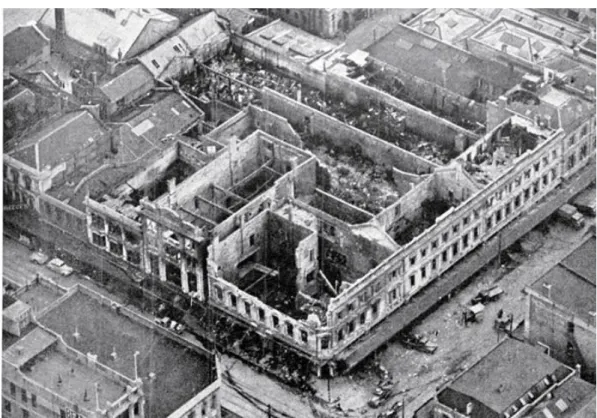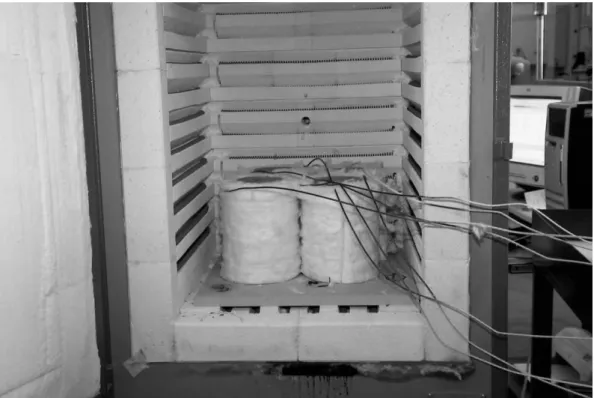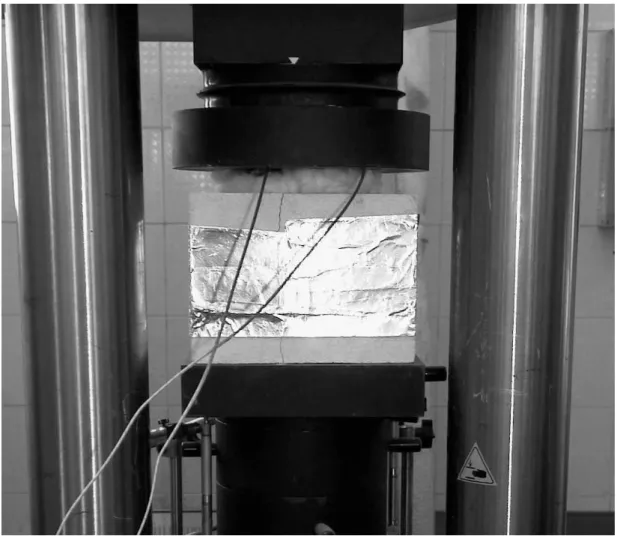Introduction
1.1 Overview
This Ph. D. dissertation deals with the mechanical behavior of masonry elements subjected to fire action, in its theoretical and experimental aspects, and can be read also as guide, as far as possible, to the structural fire design according to the criteria specified in the most recent European regulations.
As showed by past events (Fig. 1.1), from a physical point of view, the stability of a masonry wall in the presence of high temperatures is affected generally by a change in its strength and its stiffness as well as the significant thermal expansion induced. This is particularly relevant if the fire occurs on only one side of the wall: the asymmetric change of strength and stiffness, combined to asymmetrical deformations generally produces an alteration of the compressive stresses, due to
the increased eccentricity, a raise of deformations, due to the reduced stiffness, and finally a decrease in load-bearing capacity.
Fig. 1.1: The masonry walls of Ballantines department store after a severe fire. New Zeland, 1947.
This dissertation develops a study to predict the out-of-plane collapse behavior from experimental investigations and analytical models.
The thesis consists of six chapters, the second of which presents the procedures of analysis and assessment of masonry structures subjected to fire, according to the indications of EN 1996-1-2 [1]: in particular, following the indications of the general rules for structural designing for fire safety, the tabular data methods and those related to direct simplified and advanced calculation for elements, parts or entire structures are presented. The methods for fire resistance classification by experimental tests on full scale elements (Figure 1.2 and 1.3) are not addressed.
Fig. 1.2: Full scale testing of a masonry panel.
A
B
0 20 40 60 80 100 120 0 30 60 90 120 150 180 210 240 H or iz ont al D is p la cem en t [m m ] Time [min] Point A [mm] Point B [mm]Fig. 1.3: Example of full scale testing of a non load-bearing wall (thickness of 15cm) and horizontal displacements recorded during the exposure to nominal fire.
In the chapter 3, an experimental campaign is presented to determine the effects of high temperatures to the mechanical properties of several materials for masonry walls (blocks, mortars), testing a series of cylindrical specimens (diameter 100 mm – height 200 mm).
After compression tests at 20°C, an experimental procedure were designed for high temperatures testing. The cylindrical elements were inserted on a muffle furnace (Fig. 1.4), to reach the required temperature, and then subjected to mechanical compression after entering in a specific apparatus (called “thermos”) to maintain the prescribed temperature.
Fig. 1.4: Cylindrical specimens in the muffle furnace.
The tests were performed on a set of temperatures between 20°C and 700°C (Fig. 1.5). The compressive strength, ultimate strain (in absence of preload), free thermal strain and the equivalent Young modulus were measured for each test, in
comparison with results obtained from tests carried out at room temperature (20°C): specific diagrams are performed for each material in the chapter 4 with the aim to give to the readers experimental information on the main materials used for blocks and mortar joints, measuring the variation of compressive strength and deformation properties depending on the temperature. Possible variations of strength and ultimate strain at high temperatures due to the preload were then not investigated.
Moreover, stress-strain curves in function of temperature are proposed and compared with those drown by European regulations.
A methodology for the prediction of equivalent masonry parameters is also proposed with a model of layered elastic wall panels.
The out-of-plane mechanical behaviour is investigated in the chapter 5. The method proposed herein aims to define such crushing domains for walls subjected to the eccentric axial force acting on various types of blocks exposed to fire on one side. To this end, the temperature distributions across the wall thickness are first determined. Then, as the laws governing the decay of the material resistance and axial stiffness as a function of the temperature are known, the wall crushing strain fields are calculated as a function of the curvature. Lastly, the crushing surfaces on the plane N–e (in which N is the axial force and e is the out-of-plane eccentricity) for increasing exposure time to nominal fire are determined, following the isotherms already calculated and the stress–strain–temperature constitutive relations.
1.2 State of the art
The mechanical behaviour of masonry walls subjected to high temperatures is of relevant interest for structural design of load-bearing panels or non load-bearing panels with fire safety properties.
Several aspects influence the mechanical response of a masonry wall at high temperatures: the mechanical properties of blocks and mortar, the geometrical texture, the size and shape of blocks and mortar joints, the dimensions and
restrains of the panel, the modality of exposure to high temperature, the humidity content etc; thus it is complicated to determine simple rules to predict the variation of strength and deformation parameters, also in the simplest stress condition such as uniform compression. Further experimental information is then useful for a better comprehension and design of masonry walls subjected to high temperatures.
Although the response to fire of masonry walls has been the subject of a series of past studies reported by Lawrence and Ghanakrishnan [2] and Byrne [3], only more recently have experimental results been compared with those from numerical models. Firstly, Gnanakrishnan and Lawther [4] developed a simplified plane strain finite element model, obtaining results over conservative. O’Meagher and Bennets [5] produced a computer procedure based on the moment–curvature method of analysis: the thermo–structural model allowed for geometric as well as material non-linearity, and was capable of predicting the thermal bowing of both reinforced and unreinforced concrete walls in plane stress.
In [6 and 7], Nadjai et al. reported on numerical studies of the behaviour of walls conducted in the presence of fire on one side. They assumed two preset curves of the compression strength-temperature relation proposed by Abrams in [8] and Thelanderson in [9] and two possible curves for the crushing strain-temperature relation proposed by Terro in [10] and Anderberg in [11]: these data were obtained from experimental test on ordinary concrete specimens. The stress–strain curve shown in Fig. 1.6 depicts a classical relation, with two descending segments whose shapes differ in the two regions of different strain signs.
Fig. 1.6: Stress–strain relation of masonry materials under compression and tension, drawn from [6 and 7].
In more recent works [12 and 13], Nadjai et al. implemented in their model the solution for the compatibility of the linear flexural strain distributions with curvi-linear temperature profiles, as presented by O’Connor and Scotney in [14].
In [15], Al Nahhas et al. addressed the case of walls made of hollow bricks, which were subjected to experimental tests and subsequent analytical modelling. The distribution of the isotherms was determined through an energy balance approach by measuring the proportions of convection, conduction and radiation: the temperature-time curves were determined in various points throughout the wall thickness. Another relevant contribution to the experimental investigation of the behavior of clay hollow-brick masonry walls during fire is given by Nguyen and Meftah in [16], where the high performances detected in terms of exposure time to nominal fire are presented (Figures 1.7 and 1.8).
In order to check the experimental results reported in [17] by Shields et al. , Dhanasekar et al. [18] carried out numerical analysis in a thermal field to determine the bowing of panels exposed to fire.
Fig. 1.7: Nguyen and Meftah [16]: non load-bearing thick wall after 360min of fire exposure, view of the exposed side.
Fig. 1.8: Nguyen and Meftah [16]: full scale specimen after fire testing procedure: exposed (left) and unexposed (right) side.
With regard to regulations, the recent adoption of the Eurocodes on structures, in particular the adjustments to EN 1996-1-2 [1], has led to the application of new methods for experimental or analytical tabular design of bearing masonry walls, partially based on the results of a series of experimental trials conducted by Hahn et al. [19]. The analytical methods prescribed in the Eurocodes depend from the knowledge of the ultimate strain and compression resistance as functions of temperature, as well as the main thermal parameters (conductivity, specific heat and density). It should however be noted that some such parameters are significantly influenced by brick humidity, as reported by Nguyen et al. in [20] (Fig. 1.9), so caution should be exercised when applying standard diagrams in the design process.
Fig. 1.9: Heat capacity evolution considered by Nguyen et al. in [20], where the peak at 100°C is to model the humidity content.
An expanded overview of the state of the art related to mechanical behavior and properties of masonry exposed to high temperature is also given by Russo and Sciarretta in [21].

![Fig. 1.2: Full scale testing of a masonry panel. A B 020406080100120 0 30 60 90 120 150 180 210 240Horizontal Displacement[mm] Time [min]Point A [mm]Point B [mm]](https://thumb-eu.123doks.com/thumbv2/123dokorg/7615418.115700/3.892.194.786.170.697/scale-testing-masonry-panel-horizontal-displacement-point-point.webp)


![Fig. 1.6: Stress–strain relation of masonry materials under compression and tension, drawn from [6 and 7]](https://thumb-eu.123doks.com/thumbv2/123dokorg/7615418.115700/8.892.123.695.173.369/stress-strain-relation-masonry-materials-compression-tension-drawn.webp)
![Fig. 1.7: Nguyen and Meftah [16]: non load-bearing thick wall after 360min of fire exposure, view of the exposed side](https://thumb-eu.123doks.com/thumbv2/123dokorg/7615418.115700/9.892.332.645.164.615/fig-nguyen-meftah-load-bearing-thick-exposure-exposed.webp)
![Fig. 1.9: Heat capacity evolution considered by Nguyen et al. in [20], where the peak at 100°C is to model the humidity content](https://thumb-eu.123doks.com/thumbv2/123dokorg/7615418.115700/10.892.153.637.637.984/heat-capacity-evolution-considered-nguyen-model-humidity-content.webp)